

Anthropologie. Afrique du Sud : le squelette pré-humain "le plus complet" jamais découvert. Les premiers excès de la chasse, il y a 45 000 ans. La paléogénétique révèle une humanité éclatée. L'homme de Néandertal en déficit de liens sociaux. Origine africaine de l'homme moderne. Un article de Wikipédia, l'encyclopédie libre.

En paléoanthropologie, l'origine africaine de l'homme moderne est le modèle théorique dominant le plus ancien pour décrire l'origine et les premières migrations humaines de l'homme moderne, Homo sapiens. The Later Stone Age Calvaria from Iwo Eleru, Nigeria: Morphology and Chronology. Corrections 7 Nov 2013: Harvati K, Stringer C, Grün R, Aubert M, Allsworth-Jones P, et al. (2013)Correction: The Later Stone Age Calvaria from Iwo Eleru, Nigeria: Morphology and Chronology.PLoS ONE 8(11):10.1371/annotation/887b6c18-6c37-44d2-8a50-2760bc9ad5d6. doi: 10.1371/annotation/887b6c18-6c37-44d2-8a50-2760bc9ad5d6 | View correction Background In recent years the Later Stone Age has been redated to a much deeper time depth than previously thought.
At the same time, human remains from this time period are scarce in Africa, and even rarer in West Africa. Patchwork people: Our hybrid origins - life - 02 August 2011. Editorial: "Welcome to the complicated human family" In the past year, we've learned that early Homo sapiens interbred with other hominins – and it's forcing us to rethink our family tree ONCE upon a time the human story seemed so simple.
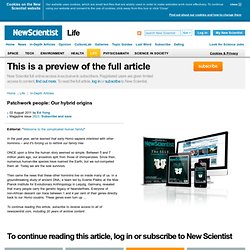
Between 5 and 7 million years ago, our ancestors split from those of chimpanzees. Since then, numerous human-like species have roamed the Earth, but we out-competed them all. Today we are the sole survivors. Then came the news that these other hominins live on inside many of us. Neanderthal genome reveals interbreeding with humans - life - 06 May 2010. Read full article Continue reading page |1|2 How closely are Neanderthals related to us?
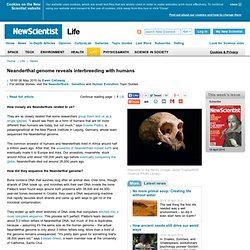
They are so closely related that some researchers group them and us as a single species. "I would see them as a form of humans that are bit more different than humans are today, but not much," says Svante Pääbo, a palaeogeneticist at the Max Planck Institute in Leipzig, Germany, whose team sequenced the Neanderthal genome. The common ancestor of humans and Neanderthals lived in Africa around half a million years ago. How did they sequence the Neanderthal genome? Bone contains DNA that survives long after an animal dies. Skull points to a more complex human evolution in Africa. 16 September 2011Last updated at 16:43 By Daniel Boettcher BBC News Professor Chris Stringer compares one of the 13,000-year-old skulls (centre) with modern (l) and ancient (r) African fossils Scientists have collected more evidence to suggest that ancient and modern humans interbred in Africa.

Reanalysis of the 13,000-year-old skull from a cave in West Africa reveals a skull more primitive-looking than its age suggests. The result suggests that the ancestors of early humans did not die out quickly in Africa, but instead lived alongside their descendents and bred with them until comparatively recently. The results are published in PLoS ONE. The skull, found in the Iwo Eleru cave in Nigeria in 1965, does not look like a modern human.
It is longer and flatter with a strong brow ridge; features closer to a much older skull from Tanzania, thought to be around 140,000 years old. The American Journal of Human Genetics - An African American Paternal Lineage Adds an Extremely Ancient Root to the Human Y Chromosome Phylogenetic Tree. To view the full text, please login as a subscribed user or purchase a subscription.
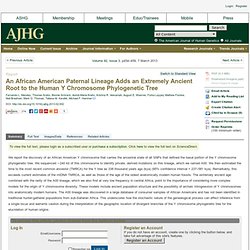
Click here to view the full text on ScienceDirect. Figure 1 Genealogy of A00, A0, and the Reference Sequence Lineages on which mutations were identified and lineages that were used for placing those mutations on the genealogy are indicated with thick and thin lines, respectively. AJHG - A Revised Root for the Human Y Chromosomal Phylogenetic Tree: The Origin of Patrilineal Diversity in Africa.
To view the full text, please login as a subscribed user or purchase a subscription.
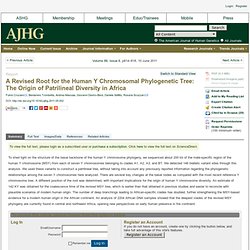
Click here to view the full text on ScienceDirect. Figure 1 Revised Human Y Chromosome Phylogeny The tree is based on the 146 mutations detected in the present study. Mutations are shown along the branches (indels in italics). Figure 2 Comparison of Human Y Chromosome Phylogenies Backbones of the MSY phylogeny as reported in the present study (to the left) and by Karafet et al.13 (to the right).
To shed light on the structure of the basal backbone of the human Y chromosome phylogeny, we sequenced about 200 kb of the male-specific region of the human Y chromosome (MSY) from each of seven Y chromosomes belonging to clades A1, A2, A3, and BT. The father of all men is 340,000 years old - life - 06 March 2013. Albert Perry carried a secret in his DNA: a Y chromosome so distinctive that it reveals new information about the origin of our species.
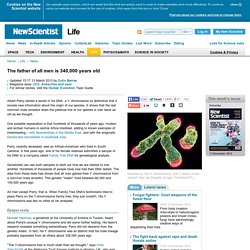
It shows that the last common male ancestor down the paternal line of our species is over twice as old as we thought. One possible explanation is that hundreds of thousands of years ago, modern and archaic humans in central Africa interbred, adding to known examples of interbreeding – with Neanderthals in the Middle East, and with the enigmatic Denisovans somewhere in southeast Asia. Perry, recently deceased, was an African-American who lived in South Carolina. A few years ago, one of his female relatives submitted a sample of his DNA to a company called Family Tree DNA for genealogical analysis.
Geneticists can use such samples to work out how we are related to one another. All men except Perry, that is. Deeper roots "It's a cool discovery," says Jon Wilkins of the Ronin Institute in Montclair, New Jersey. Older than humanity What are the implications? L’homme qui ne descendait pas d’Adam.